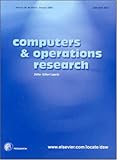|
|
Help |
| Home - Theorems And Conjectures - Traveling Salesman Problem (Books) | |
e99 Online Shopping Mall
|
|
Help |
| Home - Theorems And Conjectures - Traveling Salesman Problem (Books) | |
| 1-18 of 18 |
click price to see details click image to enlarge click link to go to the store
| 1. The Traveling Salesman Problem and Its Variations (Combinatorial Optimization) | |
 | Paperback: 830
Pages
(2007-05-18)
list price: US$99.00 -- used & new: US$74.11 (price subject to change: see help) Asin: 0387444599 Canada | United Kingdom | Germany | France | Japan |
|
Editorial Review Product Description A brilliant treatment of a knotty problem in computing. This volume contains chapters written by reputable researchers and provides the state of the art in theory and algorithms for the traveling salesman problem (TSP). The book covers all important areas of study on TSP, including polyhedral theory for symmetric and asymmetric TSP, branch and bound, and branch and cut algorithms, probabilistic aspects of TSP, and includes a thorough computational analysis of heuristic and metaheuristic algorithms. | |
| 2. The Traveling Salesman Problem: A Computational Study (Princeton Series in Applied Mathematics) by David L. Applegate, Robert E. Bixby, Vasek Chvatal, William J. Cook | |
 | Hardcover: 606
Pages
(2007-01-15)
list price: US$70.00 -- used & new: US$47.25 (price subject to change: see help) Asin: 0691129932 Average Customer Review: Canada | United Kingdom | Germany | France | Japan |
|
Editorial Review Product Description Customer Reviews (2)
| |
| 3. The Traveling Salesman Problem: A Guided Tour of Combinatorial Optimization (Wiley Series in Discrete Mathematics & Optimization) by E. L. Lawler, Jan Karel Lenstra, A. H. G. Rinnooy Kan, D. B. Shmoys | |
 | Hardcover: 476
Pages
(1985-09)
list price: US$455.00 -- used & new: US$189.00 (price subject to change: see help) Asin: 0471904139 Average Customer Review: Canada | United Kingdom | Germany | France | Japan |
|
Editorial Review Product Description Customer Reviews (1)
| |
| 4. Simulated Annealing und verwandte Verfahren für das Traveling Salesman Problem: Zur Studie gehört Software, die nur in digitaler Form (CD oder Download) erhältlich ist. (German Edition) by Andy Ruigies | |
 | Paperback: 80
Pages
(1995-01-01)
list price: US$59.90 -- used & new: US$59.90 (price subject to change: see help) Asin: 3838606167 Canada | United Kingdom | Germany | France | Japan |
|
Editorial Review Product Description | |
| 5. Effiziente Heuristiken Fur Das Probabilistische Traveling Salesman Problem by Silke Rosenow | |
| Paperback: 184
Pages
(2002-04)
list price: US$30.95 -- used & new: US$113.21 (price subject to change: see help) Asin: 3631392001 Canada | United Kingdom | Germany | France | Japan | |
| 6. Extension of the 2-p-opt and 1-shift algorithms to the heterogeneous probabilistic traveling salesman problem [An article from: European Journal of Operational Research] by L. Bianchi, A.M. Campbell | |
 | Digital:
Pages
(2007-01-01)
list price: US$7.95 -- used & new: US$7.95 (price subject to change: see help) Asin: B000PAUK2S Canada | United Kingdom | Germany | France | Japan |
|
Editorial Review Product Description | |
| 7. Lösungsverfahren für das 2-dimensionale, euklidische Traveling Salesman Problem unter besonderer Berücksichtigung der Delaunay-Triangulation by Silvia Annette Schiemann | |
| Paperback:
Pages
(2005-01-30)
-- used & new: US$64.75 (price subject to change: see help) Asin: B001T4EJ4Y Canada | United Kingdom | Germany | France | Japan | |
| 8. The traveling salesman problem as a benchmark test for a Social-Based Genetic Algorithm.(Technical report): An article from: Journal of Computer Science by Nagham Azmi al- Madi, Ahamad Tajudin Khader | |
| Digital: 12
Pages
(2008-10-01)
list price: US$9.95 -- used & new: US$9.95 (price subject to change: see help) Asin: B002S1WRHI Canada | United Kingdom | Germany | France | Japan | |
|
Editorial Review Product Description | |
| 9. Self-Optimizing Stochastic Systems: Applications To Stochastic Shortest Path Problem, Stochastic Traveling Salesman Problem, and Queueing by Thusitha Sen Jayawardena | |
| Paperback:
Pages
(1990)
Asin: B000MYHBOM Canada | United Kingdom | Germany | France | Japan | |
| 10. Aggregation for the probabilistic traveling salesman problem [An article from: Computers and Operations Research] by A.M. Campbell | |
 | Digital: 21
Pages
(2006-09-01)
list price: US$7.95 -- used & new: US$7.95 (price subject to change: see help) Asin: B000RR8ZIK Canada | United Kingdom | Germany | France | Japan |
|
Editorial Review Product Description | |
| 11. Local search for the probabilistic traveling salesman problem: Correction to the 2-p-opt and 1-shift algorithms [An article from: European Journal of Operational Research] by L. Bianchi, J. Knowles, N. Bowler | |
 | Digital:
Pages
(2005-04-01)
list price: US$7.95 -- used & new: US$7.95 (price subject to change: see help) Asin: B000RR2Q7G Canada | United Kingdom | Germany | France | Japan |
|
Editorial Review Product Description | |
| 12. Data structures and ejection chains for solving large-scale traveling salesman problems [An article from: European Journal of Operational Research] by D. Gamboa, C. Rego, F. Glover | |
 | Digital:
Pages
(2005-01-01)
list price: US$7.95 -- used & new: US$7.95 (price subject to change: see help) Asin: B000RR2PDQ Canada | United Kingdom | Germany | France | Japan |
|
Editorial Review Product Description | |
| 13. A hybrid scatter search for the probabilistic traveling salesman problem [An article from: Computers and Operations Research] by Y.-H. Liu | |
 | Digital:
Pages
(2007-08-01)
list price: US$7.95 -- used & new: US$7.95 (price subject to change: see help) Asin: B000PDU39K Canada | United Kingdom | Germany | France | Japan |
|
Editorial Review Product Description | |
| 14. Implementation analysis of efficient heuristic algorithms for the traveling salesman problem [An article from: Computers and Operations Research] by D. Gamboa, C. Rego, F. Glover | |
 | Digital: 18
Pages
(2006-04-01)
list price: US$7.95 -- used & new: US$7.95 (price subject to change: see help) Asin: B000RR8YRM Canada | United Kingdom | Germany | France | Japan |
|
Editorial Review Product Description | |
| 15. A Bicriterion Traveling Salesman Problem by Chyuan Perng | |
| Paperback:
Pages
(1989)
Asin: B000MYFIA6 Canada | United Kingdom | Germany | France | Japan | |
| 16. Meta-RaPS: a simple and effective approach for solving the traveling salesman problem [An article from: Transportation Research Part E] by G.W. DePuy, R.J. Moraga, G.E. Whitehouse | |
 | Digital:
Pages
(2005-03-01)
list price: US$10.95 -- used & new: US$10.95 (price subject to change: see help) Asin: B000RR4L88 Canada | United Kingdom | Germany | France | Japan |
|
Editorial Review Product Description | |
| 17. sBAM in solving Traveling Salesman Problem: A Cost Efficient Algorithm sBAM in Comparison to Genetic Algorithm for Solving the Traveling Salesman Problem by Boshir Ahmed, Abdullah Al Mohammad | |
 | Paperback: 64
Pages
(2010-07-13)
list price: US$62.00 -- used & new: US$48.70 (price subject to change: see help) Asin: 3838383702 Canada | United Kingdom | Germany | France | Japan |
|
Editorial Review Product Description | |
| 18. Traveling Salesman Problem for Surveillance Mission Using Particle Swarm Optimization by Barry R. Secreat | |
 | Spiral-bound: 131
Pages
(2001)
-- used & new: US$31.95 (price subject to change: see help) Asin: 1423528735 Canada | United Kingdom | Germany | France | Japan |
|
Editorial Review Product Description | |
| 1-18 of 18 |